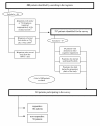Knowledge of stroke risk factors among primary care patients with previous stroke or TIA: a questionnaire study
- PMID: 20550690
- PMCID: PMC2894756
- DOI: 10.1186/1471-2296-11-47
Knowledge of stroke risk factors among primary care patients with previous stroke or TIA: a questionnaire study
Abstract
Background: Survivers of stroke or transient ischaemic attacks (TIA) are at risk of new vascular events. Our objective was to study primary health care patients with stroke/TIA regarding their knowledge about risk factors for having a new event of stroke/TIA, possible associations between patient characteristics and patients' knowledge about risk factors, and patients' knowledge about their preventive treatment for stroke/TIA.
Methods: A questionnaire was distributed to 240 patients with stroke/TIA diagnoses, and 182 patients (76%) responded. We asked 13 questions about diseases/conditions and lifestyle factors known to be risk factors and four questions regarding other diseases/conditions ("distractors"). The patients were also asked whether they considered each disease/condition to be one of their own. Additional questions concerned the patients' social and functional status and their drug use. The t-test was used for continuous variables, chi-square test for categorical variables, and a regression model with variables influencing patient knowledge was created.
Results: Hypertension, hyperlipidemia and smoking were identified as risk factors by nearly 90% of patients, and atrial fibrillation and diabetes by less than 50%. Few patients considered the distractors as stroke/TIA risk factors (3-6%). Patients with a family history of cardiovascular disease, and patients diagnosed with carotid stenosis, atrial fibrillation or diabetes, knew these were stroke/TIA risk factors to a greater extent than patients without these conditions. Atrial fibrillation or a family history of cardiovascular disease was associated with better knowledge about risk factors, and higher age, cerebral haemorrhage and living alone with poorer knowledge. Only 56% of those taking anticoagulant drugs considered this as intended for prevention, while 48% of those taking platelet aggregation inhibitors thought this was for prevention.
Conclusions: Knowledge about hypertension, hyperlipidemia and smoking as risk factors was good, and patients who suffered from atrial fibrillation or carotid stenosis seemed to be well informed about these conditions as risk factors. However, the knowledge level was low regarding diabetes as a risk factor and regarding the use of anticoagulants and platelet aggregation inhibitors for stroke/TIA prevention. Better teaching strategies for stroke/TIA patients should be developed, with special attention focused on diabetic patients.
Figures


Similar articles
-
Atrial Fibrillation in Transient Ischemic Attack Versus Ischemic Stroke: A Swedish Stroke Register (Riksstroke) Study.Stroke. 2016 Oct;47(10):2456-61. doi: 10.1161/STROKEAHA.116.013988. Epub 2016 Aug 25. Stroke. 2016. PMID: 27561674
-
Development of a scoring system for atrial fibrillation in acute stroke and transient ischemic attack patients: the LADS scoring system.J Neurol Sci. 2011 Feb 15;301(1-2):27-30. doi: 10.1016/j.jns.2010.11.011. Epub 2010 Dec 4. J Neurol Sci. 2011. PMID: 21130468
-
Ischemic Stroke and Transient Ischemic Attack Risk Following Vitamin K Antagonist Cessation in Newly Diagnosed Atrial Fibrillation: A Cohort Study.J Am Heart Assoc. 2020 Jan 21;9(2):e014376. doi: 10.1161/JAHA.119.014376. Epub 2020 Jan 15. J Am Heart Assoc. 2020. PMID: 31937194 Free PMC article.
-
Preventing strokes: the assessment and management of people with transient ischaemic attack.N Z Med J. 2009 Apr 24;122(1293):3556. N Z Med J. 2009. PMID: 19448791 Review.
-
Long-term outcome after ischaemic stroke/transient ischaemic attack.Cerebrovasc Dis. 2003;16 Suppl 1:14-9. doi: 10.1159/000069936. Cerebrovasc Dis. 2003. PMID: 12698014 Review.
Cited by
-
Knowledge on Signs and Risk Factors in Stroke Patients.J Clin Med. 2020 Aug 7;9(8):2557. doi: 10.3390/jcm9082557. J Clin Med. 2020. PMID: 32784554 Free PMC article.
-
Streamlining atrial fibrillation ablation management using a digitization solution.Eur Heart J Digit Health. 2024 May 23;5(4):483-490. doi: 10.1093/ehjdh/ztae041. eCollection 2024 Jul. Eur Heart J Digit Health. 2024. PMID: 39081948 Free PMC article.
-
Factors associated with young adults' knowledge regarding family history of Stroke.Rev Lat Am Enfermagem. 2016 Nov 21;24:e2814. doi: 10.1590/1518-8345.1285.2814. Rev Lat Am Enfermagem. 2016. PMID: 27878217 Free PMC article.
-
Knowledge and Response to Stroke Among Lebanese Adults: A Population-Based Survey.Front Public Health. 2022 Jun 3;10:891073. doi: 10.3389/fpubh.2022.891073. eCollection 2022. Front Public Health. 2022. PMID: 35719671 Free PMC article.
-
Popular stroke knowledge in Brazil: A multicenter survey during "World Stroke Day".eNeurologicalSci. 2016 Dec 16;6:63-67. doi: 10.1016/j.ensci.2016.12.002. eCollection 2017 Mar. eNeurologicalSci. 2016. PMID: 29260013 Free PMC article.
References
Publication types
MeSH terms
LinkOut - more resources
Full Text Sources
Medical

